Energy Harvester Based on Mechanical Impacts of an Oscillating Rod on Piezoelectric Transducers
Abstract
1. Introduction
2. Materials and Methods
2.1. Characterization of Piezoelectric Transducers
2.2. Three-Dimensional Structure for Piezoelectric Impact Generation
2.3. Testing of Electric Power Generation
2.4. Mechanical Interaction between the 3D Printing Material and the Piezoelectric Disk
2.5. Estimation of Harvested Energy Using Multiple Piezoelectric Disks
2.6. On-Site Tests of the Oscillatory Behavior of the Proposed Generator on Footbridge
3. Results
3.1. Characterization of Piezoelectric Transducers
3.2. Testing of Electric Power Generation
3.3. Comparison of the Mechanical Behavior of the Impacting Material
3.4. Simulated Behavior of the Power Generation System
3.5. On-Site Tests of the Oscillatory Behavior of the Proposed Generator on Footbridge
4. Discussion
4.1. Testing of Electric Power Generation
4.2. Simulated Behavior of the Power Generation System
4.3. On-Site Tests of the Oscillatory Behavior of the Proposed Generator on Footbridge
5. Conclusions
Author Contributions
Funding
Informed Consent Statement
Data Availability Statement
Acknowledgments
Conflicts of Interest
References
- Pradeesh, E.L.; Udhayakumar, S.; Vasundhara, M.G.; Kalavathi, G.K. A Review on Piezoelectric Energy Harvesting. Microsyst. Technol. 2022, 28, 1797–1830. [Google Scholar] [CrossRef]
- Sezer, N.; Koç, M. A Comprehensive Review on the State-of-the-Art of Piezoelectric Energy Harvesting. Nano Energy 2021, 80, 105567. [Google Scholar] [CrossRef]
- Ding, G.; Zhao, X.; Wang, J.; Xu, C. Vibration Energy Harvesting from Roads under Traffic Loads. Road Mater. Pavement Des. 2020, 21, 780–799. [Google Scholar] [CrossRef]
- Kütt, L.; Millar, J.; Karttunen, A.; Lehtonen, M.; Karppinen, M. Thermoelectric Applications for Energy Harvesting in Domestic Applications and Micro-Production Units. Part I: Thermoelectric Concepts, Domestic Boilers and Biomass Stoves. Renew. Sustain. Energy Rev. 2018, 98, 519–544. [Google Scholar] [CrossRef]
- Priya, S.; Song, H.C.; Zhou, Y.; Varghese, R.; Chopra, A.; Kim, S.G.; Kanno, I.; Wu, L.; Ha, D.S.; Ryu, J.; et al. A Review on Piezoelectric Energy Harvesting: Materials, Methods, and Circuits. Energy Harvest. Syst. 2019, 4, 3–39. [Google Scholar] [CrossRef]
- Liu, Y.; Shang, S.; Mo, S.; Wang, P.; Wang, H. Eco-Friendly Strategies for the Material and Fabrication of Wearable Sensors. Int. J. Precis. Eng. Manuf.-Green Technol. 2020, 8, 1323–1346. [Google Scholar] [CrossRef]
- Bryant, M.; Wolff, E.; Garcia, E. Aeroelastic Flutter Energy Harvester Design: The Sensitivity of the Driving Instability to System Parameters. Smart Mater. Struct. 2011, 20, 125017. [Google Scholar] [CrossRef]
- Kwon, S.D. A T-Shaped Piezoelectric Cantilever for Fluid Energy Harvesting. Appl. Phys. Lett. 2010, 97, 164102. [Google Scholar] [CrossRef]
- Du, X.; Zhang, M.; Chang, H.; Wang, Y.; Yu, H. Micro Windmill Piezoelectric Energy Harvester Based on Vortex-Induced Vibration in Tunnel. Energy 2022, 238, 121734. [Google Scholar] [CrossRef]
- Rezaei-Hosseinabadi, N.; Tabesh, A.; Dehghani, R.; Aghili, A. An Efficient Piezoelectric Windmill Topology for Energy Harvesting from Low-Speed Air Flows. IEEE Trans. Ind. Electron. 2015, 62, 3576–3583. [Google Scholar] [CrossRef]
- Wang, J.; Gu, S.; Abdelkefi, A.; Zhang, M.; Xu, W.; Lai, Y. Piezoelectric Energy Harvesting from Flow-Induced Vibrations of a Square Cylinder at Various Angles of Attack. Smart Mater. Struct. 2021, 30, 8LT02. [Google Scholar] [CrossRef]
- Naqvi, A.; Ali, A.; Altabey, W.A.; Kouritem, S.A. Energy Harvesting from Fluid Flow Using Piezoelectric Materials: A Review. Energies 2022, 15, 7424. [Google Scholar] [CrossRef]
- Zhang, Y.; Cai, S.C.S.; Deng, L. Piezoelectric-Based Energy Harvesting in Bridge Systems. J. Intell. Mater. Syst. Struct. 2014, 25, 1414–1428. [Google Scholar] [CrossRef]
- Zhang, Z.; Xiang, H.; Tang, L.; Yang, W. A Comprehensive Analysis of Piezoelectric Energy Harvesting from Bridge Vibrations. J. Phys. D Appl. Phys. 2022, 56, 14001. [Google Scholar] [CrossRef]
- Sheng, W.; Xiang, H.; Zhang, Z.; Yuan, X. High-Efficiency Piezoelectric Energy Harvester for Vehicle-Induced Bridge Vibrations: Theory and Experiment. Compos. Struct. 2022, 299, 116040. [Google Scholar] [CrossRef]
- Wang, H.; Jasim, A.; Chen, X. Energy Harvesting Technologies in Roadway and Bridge for Different Applications—A Comprehensive Review. Appl. Energy 2018, 212, 1083–1094. [Google Scholar] [CrossRef]
- Clementi, G.; Cottone, F.; Di Michele, A.; Gammaitoni, L.; Mattarelli, M.; Perna, G.; López-Suárez, M.; Baglio, S.; Trigona, C.; Neri, I. Review on Innovative Piezoelectric Materials for Mechanical Energy Harvesting. Energies 2022, 15, 6227. [Google Scholar] [CrossRef]
- Yang, H.; Wei, Y.; Zhang, W.; Ai, Y.; Ye, Z.; Wang, L. Development of Piezoelectric Energy Harvester System through Optimizing Multiple Structural Parameters. Sensors 2021, 21, 2876. [Google Scholar] [CrossRef] [PubMed]
- Bao, B.; Wang, Q.; Wu, N.; Zhou, S. Hand-Held Piezoelectric Energy Harvesting Structure: Design, Dynamic Analysis, and Experimental Validation. Measurement 2021, 174, 109011. [Google Scholar] [CrossRef]
- Mhiri, M.T.; Chouchane, M.; Guerich, M.; Larbi, W. Modeling and Analysis of a Macro-Fiber Piezoelectric Bimorph Energy Harvester Operating in D33-Mode Using Timoshenko Theory. Mech. Adv. Mater. Struct. 2024, 1–15. [Google Scholar] [CrossRef]
- Ju, S.; Ji, C.H. Impact-Based Piezoelectric Vibration Energy Harvester. Appl. Energy 2018, 214, 139–151. [Google Scholar] [CrossRef]
- Wang, J.; Zhao, W.; Su, Z.; Zhang, G.; Li, P.; Yurchenko, D. Enhancing Vortex-Induced Vibrations of a Cylinder with Rod Attachments for Hydrokinetic Power Generation. Mech. Syst. Signal. Process. 2020, 145, 106912. [Google Scholar] [CrossRef]
- Zhang, M.; Zhang, C.; Abdelkefi, A.; Yu, H.; Gaidai, O.; Qin, X.; Zhu, H.; Wang, J. Piezoelectric Energy Harvesting from Vortex-Induced Vibration of a Circular Cylinder: Effect of Reynolds Number. Ocean Eng. 2021, 235, 109378. [Google Scholar] [CrossRef]
- Borowiec, M.; Bochenski, M.; Litak, G.; Teter, A. Analytical Model and Energy Harvesting Analysis of a Vibrating Slender Rod with Added Tip Mass in Three-Dimensional Space. Eur. Phys. J. Spec. Top. 2021, 230, 3581–3590. [Google Scholar] [CrossRef]
- Selleri, G.; Poli, F.; Neri, R.; Gasperini, L.; Gualandi, C.; Soavi, F.; Fabiani, D. Energy Harvesting and Storage with Ceramic Piezoelectric Transducers Coupled with an Ionic Liquid-Based Supercapacitor. J. Energy Storage 2023, 60, 106660. [Google Scholar] [CrossRef]
- Hwang, G.T.; Annapureddy, V.; Han, J.H.; Joe, D.J.; Baek, C.; Park, D.Y.; Kim, D.H.; Park, J.H.; Jeong, C.K.; Park, K.I.; et al. Self-Powered Wireless Sensor Node Enabled by an Aerosol-Deposited PZT Flexible Energy Harvester. Adv. Energy Mater. 2016, 6, 1600237. [Google Scholar] [CrossRef]
- Wang, C.; Wang, S.; Gao, Z.; Song, Z. Effect Evaluation of Road Piezoelectric Micro-Energy Collection-Storage System Based on Laboratory and on-Site Tests. Appl. Energy 2021, 287, 116581. [Google Scholar] [CrossRef]
- Staaf, H.; Matsson, S.; Sepheri, S.; Köhler, E.; Daoud, K.; Ahrentorp, F.; Jonasson, C.; Folkow, P.; Ryynänen, L.; Penttila, M.; et al. Simulated and Measured Piezoelectric Energy Harvesting of Dynamic Load in Tires. Heliyon 2024, 10, e29043. [Google Scholar] [CrossRef]

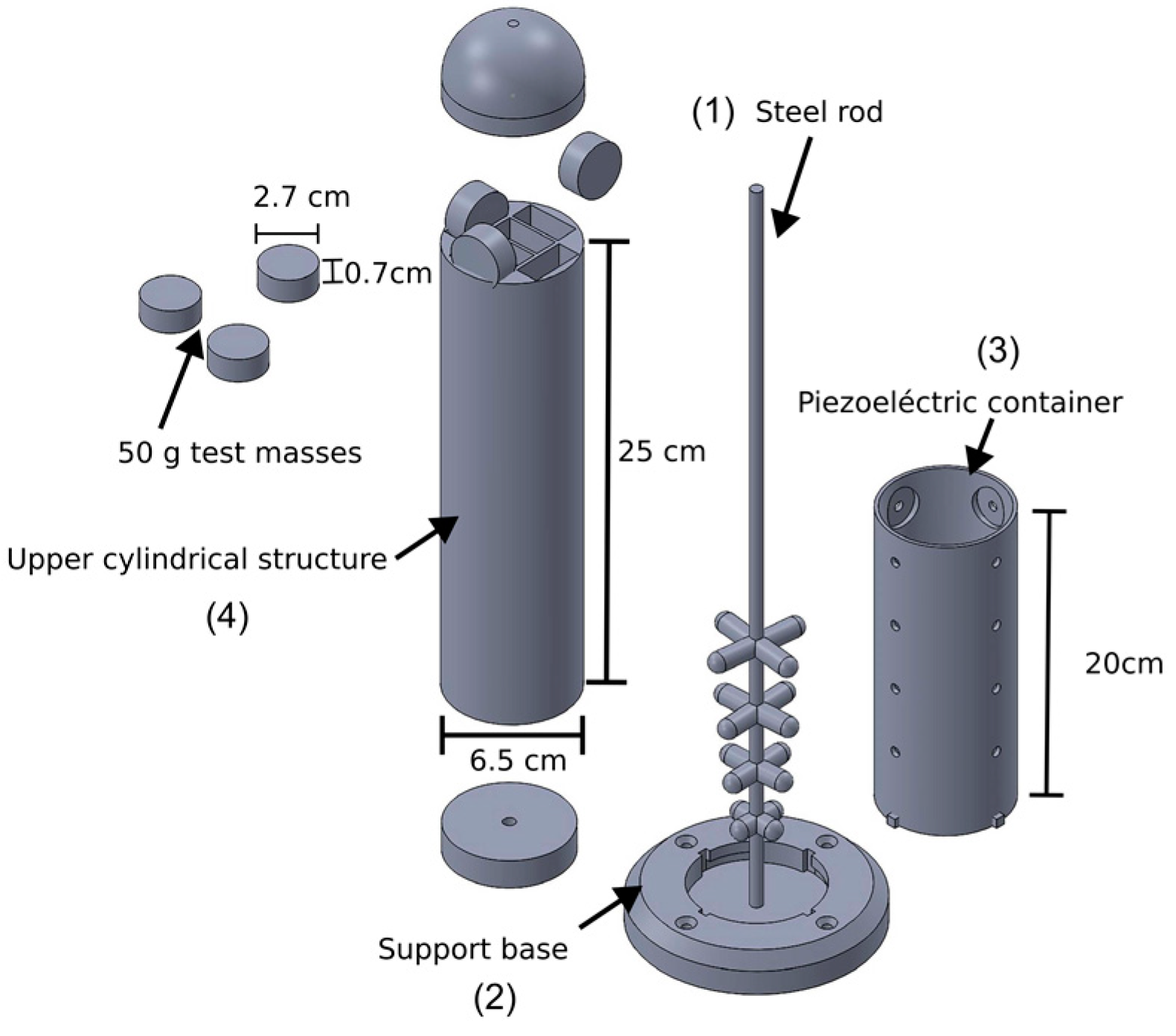

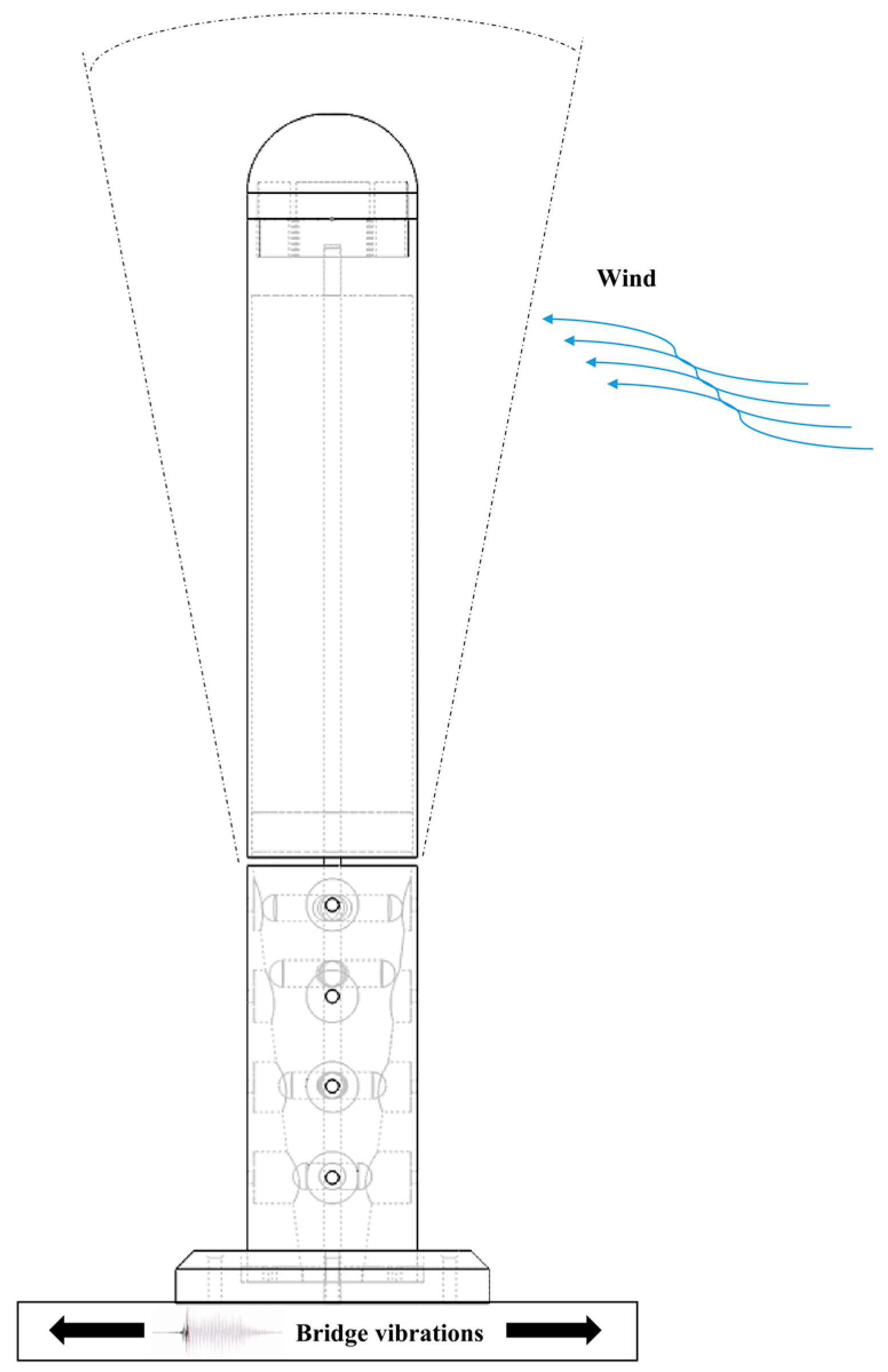
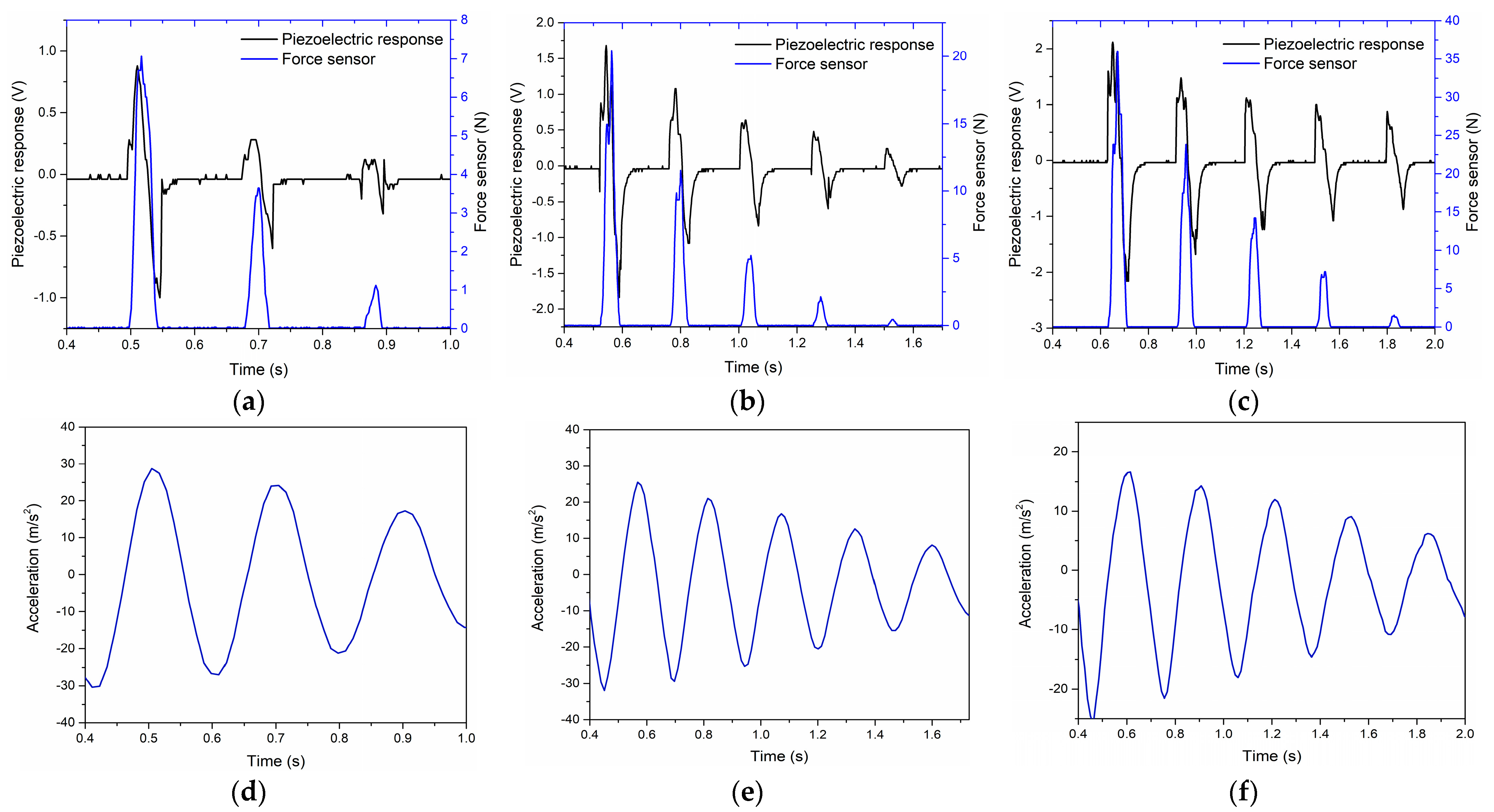




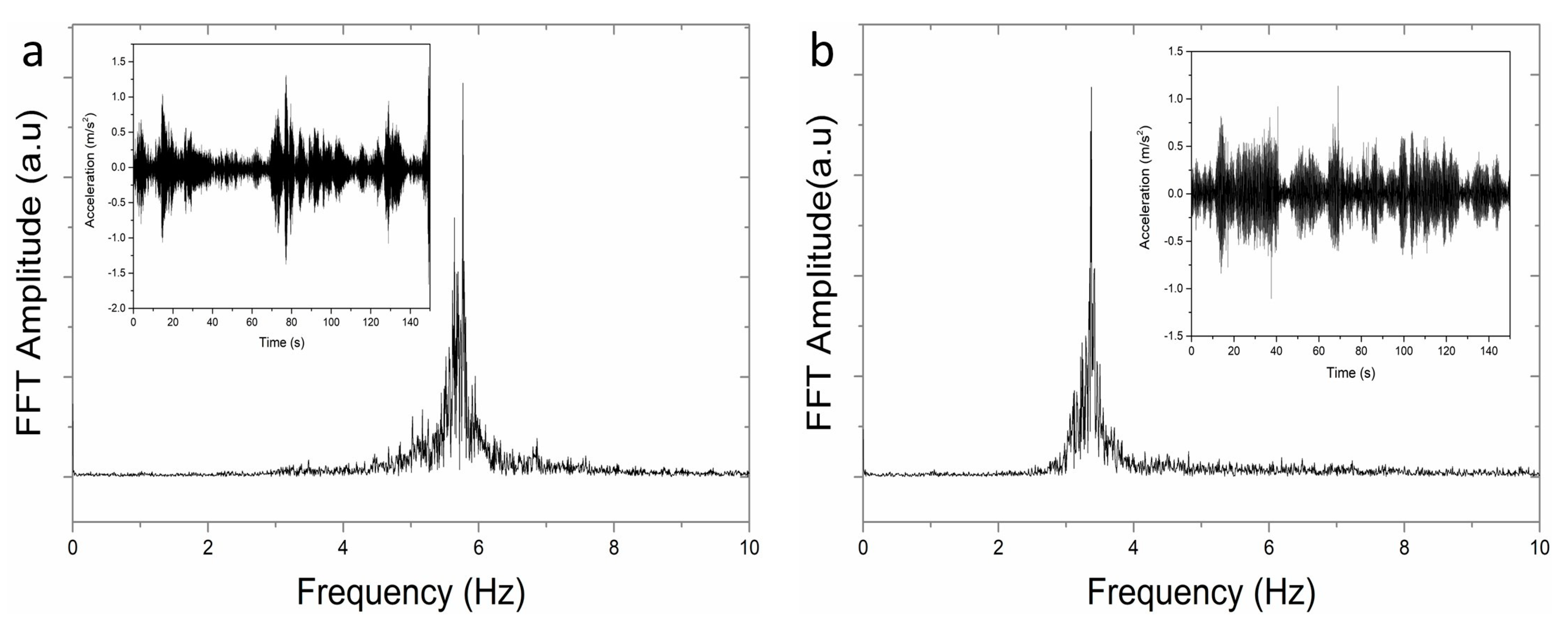
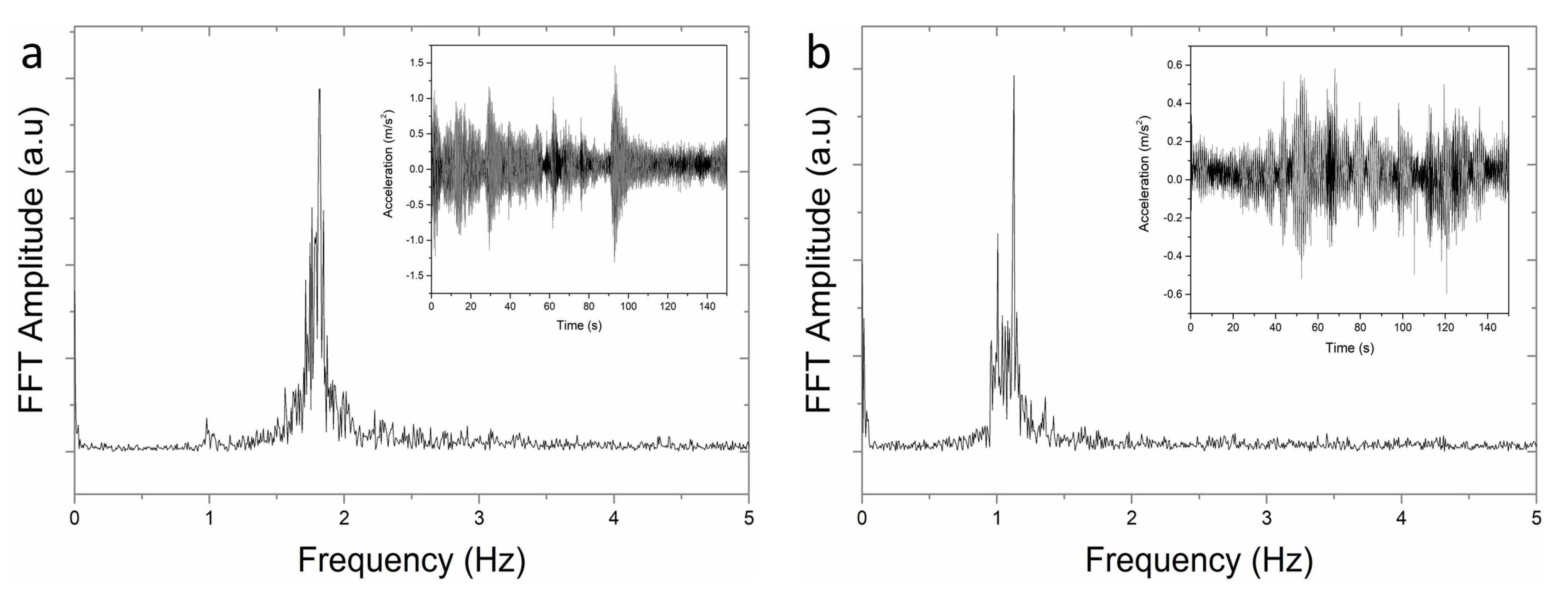

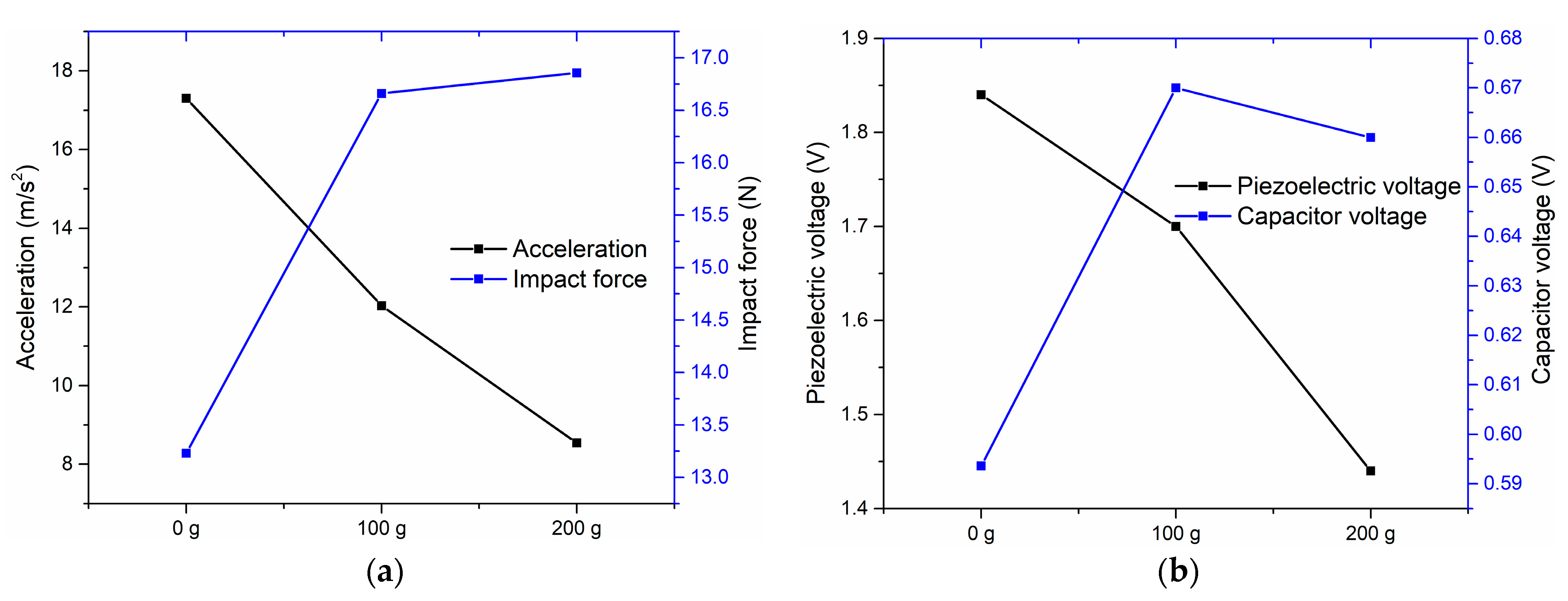
| Material | Young’s Modulus (Gpa) | Poisson’s Ratio | Yield Strength (MPa) |
|---|---|---|---|
| Brass | 89.6 | 0.35 | 379 |
| PZT | 52 | 0.34 | 150 |
| ABS | 1.9 | 0.33 | 43 |
| PLA | 2.3 | 0.38 | 60 |
| d33 [pC∙N−1] | Cp [nF] | εr | g33 [ mV∙m∙N−1] |
|---|---|---|---|
| 224 | 12.5 | 1249 | 20.2 |
Disclaimer/Publisher’s Note: The statements, opinions and data contained in all publications are solely those of the individual author(s) and contributor(s) and not of MDPI and/or the editor(s). MDPI and/or the editor(s) disclaim responsibility for any injury to people or property resulting from any ideas, methods, instructions or products referred to in the content. |
© 2024 by the authors. Licensee MDPI, Basel, Switzerland. This article is an open access article distributed under the terms and conditions of the Creative Commons Attribution (CC BY) license (https://creativecommons.org/licenses/by/4.0/).
Share and Cite
Islas-Herrera, M.A.; Sánchez-Luna, D.; Jaimes-Ponce, J.M.; Córdova-Córdova, D.A.; Lorenzo-Alfaro, C.I.; Hernández-Rivera, D. Energy Harvester Based on Mechanical Impacts of an Oscillating Rod on Piezoelectric Transducers. Clean Technol. 2024, 6, 907-920. https://doi.org/10.3390/cleantechnol6030046
Islas-Herrera MA, Sánchez-Luna D, Jaimes-Ponce JM, Córdova-Córdova DA, Lorenzo-Alfaro CI, Hernández-Rivera D. Energy Harvester Based on Mechanical Impacts of an Oscillating Rod on Piezoelectric Transducers. Clean Technologies. 2024; 6(3):907-920. https://doi.org/10.3390/cleantechnol6030046
Chicago/Turabian StyleIslas-Herrera, Marco Antonio, David Sánchez-Luna, Jorge Miguel Jaimes-Ponce, Daniel Andrés Córdova-Córdova, Christopher Iván Lorenzo-Alfaro, and Daniel Hernández-Rivera. 2024. "Energy Harvester Based on Mechanical Impacts of an Oscillating Rod on Piezoelectric Transducers" Clean Technologies 6, no. 3: 907-920. https://doi.org/10.3390/cleantechnol6030046
APA StyleIslas-Herrera, M. A., Sánchez-Luna, D., Jaimes-Ponce, J. M., Córdova-Córdova, D. A., Lorenzo-Alfaro, C. I., & Hernández-Rivera, D. (2024). Energy Harvester Based on Mechanical Impacts of an Oscillating Rod on Piezoelectric Transducers. Clean Technologies, 6(3), 907-920. https://doi.org/10.3390/cleantechnol6030046






